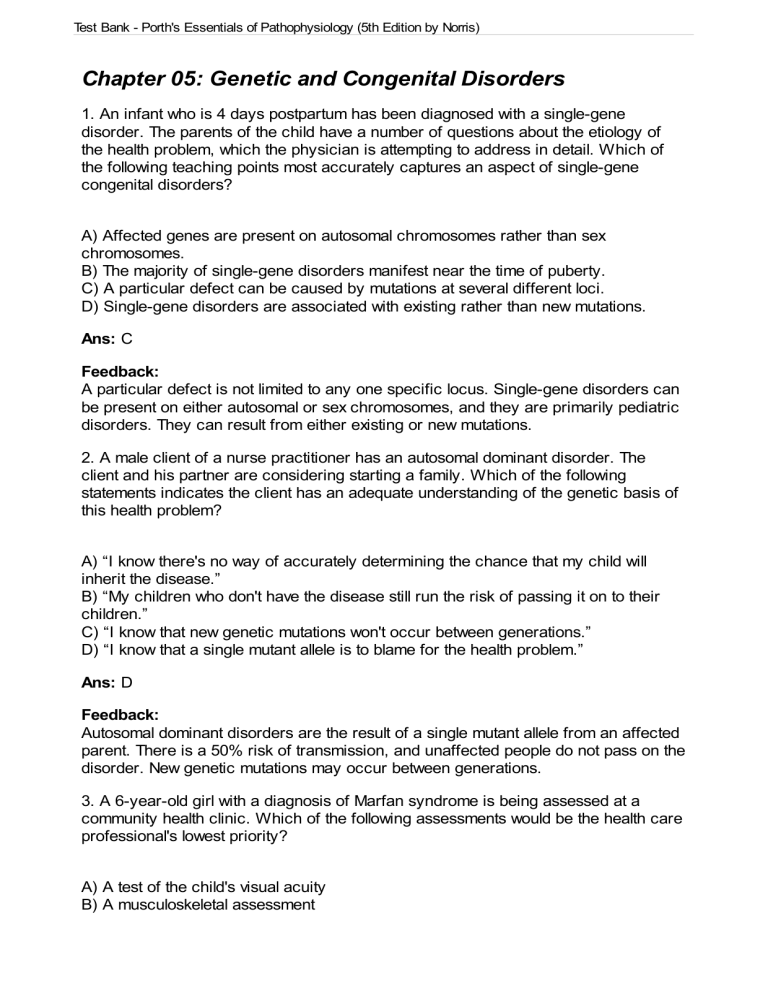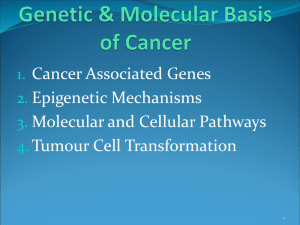
Test Bank - Porth's Essentials of Pathophysiology (5th Edition by Norris) Chapter 05: Genetic and Congenital Disorders 1. An infant who is 4 days postpartum has been diagnosed with a single-gene disorder. The parents of the child have a number of questions about the etiology of the health problem, which the physician is attempting to address in detail. Which of the following teaching points most accurately captures an aspect of single-gene congenital disorders? A) Affected genes are present on autosomal chromosomes rather than sex chromosomes. B) The majority of single-gene disorders manifest near the time of puberty. C) A particular defect can be caused by mutations at several different loci. D) Single-gene disorders are associated with existing rather than new mutations. Ans: C Feedback: A particular defect is not limited to any one specific locus. Single-gene disorders can be present on either autosomal or sex chromosomes, and they are primarily pediatric disorders. They can result from either existing or new mutations. 2. A male client of a nurse practitioner has an autosomal dominant disorder. The client and his partner are considering starting a family. Which of the following statements indicates the client has an adequate understanding of the genetic basis of this health problem? A) “I know there's no way of accurately determining the chance that my child will inherit the disease.” B) “My children who don't have the disease still run the risk of passing it on to their children.” C) “I know that new genetic mutations won't occur between generations.” D) “I know that a single mutant allele is to blame for the health problem.” Ans: D Feedback: Autosomal dominant disorders are the result of a single mutant allele from an affected parent. There is a 50% risk of transmission, and unaffected people do not pass on the disorder. New genetic mutations may occur between generations. 3. A 6-year-old girl with a diagnosis of Marfan syndrome is being assessed at a community health clinic. Which of the following assessments would be the health care professional's lowest priority? A) A test of the child's visual acuity B) A musculoskeletal assessment Test Bank - Porth's Essentials of Pathophysiology (5th Edition by Norris) C) Tests of kidney function D) Cardiovascular assessment Ans: C Feedback: The autosomal dominant disorder of Marfan syndrome is primarily manifested in the ocular, cardiovascular, and skeletal systems. These assessments would take priority over renal assessment. 4. A clinician who works on a cardiac care unit of a hospital is providing care for a number of clients. Which client most likely has a genetic disorder arising from inheritance of a single gene? A) A short, thin, 56-year-old woman with hypertension B) A tall, thin, myopic, 28-year-old woman with mitral valve prolapse C) An overweight, middle-aged male smoker with coronary artery disease D) A thin, middle-aged nonsmoking man with a repaired atrial septal defect Ans: B Feedback: This patient exhibits several classic signs of Marfan syndrome, an autosomal dominant genetic disorder of the connective tissue. The other patients show signs of heart disease most likely caused by multiple factors. 5. The nurse working in a pediatric office is scheduled to assess a female adolescent diagnosed with neurofibromatosis (NF) type 1. During this assessment, the nurse should be assessing the teenager for which of the following clinical manifestations of NF-1? Select all that apply. A) Irregular menstrual periods B) Severe scoliosis C) Hearing loss D) Complaints of having a hard time concentrating in school E) Speech impediments Ans: B, D, E Feedback: NF-1 children have many problems, often not apparent until puberty. They tend to have large tumors that cause facial disfigurement, skeletal deformities such as scoliosis, and neurologic complications like learning disabilities, attention deficit disorders, and speech abnormalities. 6. A new older female client at a long-term care facility has a diagnosis of type 1 neurofibromatosis. As part of the intake assessment protocol for the facility, the clinical educator is teaching the care staff about the diagnosis. Which of the following Test Bank - Porth's Essentials of Pathophysiology (5th Edition by Norris) statements most accurately conveys an aspect of neurofibromatosis? A) “The neurofibroma lesions are unsightly for the client, but they are not painful.” B) “Her diagnosis puts her at higher risk of developing a malignant neoplasm.” C) “She is living with an example of an autosomal recessive disorder.” D) “The client is likely to be photosensitive as a result of the disease.” Ans: B Feedback: NF-1 is associated with increased risk of malignant neoplasm. The lesions may be painful to the client, and the disease is an autosomal dominant disorder. Photosensitivity is not noted as a complication of type 1 neurofibromatosis. 7. As part of an orientation to a genetic counseling practice, a group of medical students are differentiating between autosomal recessive disorders and autosomal dominant disorders. Which of the following statements is true of autosomal recessive disorders? A) They can manifest when present in one or both gene pairs. B) There is a one in two chance of an affected child in each pregnancy with an affected mother. C) They tend to have a more uniform symptomatology than autosomal dominant disorders. D) The associated disorders are usually attributable to abnormalities in structural proteins. Ans: C Feedback: Autosomal recessive disorders tend to have a more uniform symptomology than autosomal dominant disorders. Their incidence is dependent on both members of the gene pair being affected, and there is a one in four risk of an affected child with each pregnancy. The associated disorders are usually attributable to enzyme deficiencies. 8. A 6-year-old boy who has mental retardation secondary to fragile X syndrome has been admitted to hospital with a mitral valve prolapse. A health care worker who is providing care for the family should have which of the following statements as part of her knowledge base around the disease? A) The common pattern of inheritance is an affected mother who carries one normal and one mutant allele. B) The boy's mother had a 100% chance of transmitting the defective gene to her son. C) Genes of the boy's Y chromosome can be affected in addition to the X chromosome. Test Bank - Porth's Essentials of Pathophysiology (5th Edition by Norris) D) The boy will pass the gene to all his future daughters who will become carriers. Ans: D Feedback: When the affected son procreates, he transmits the defective gene to all of his daughters, who become carriers of the mutant gene. The most common pattern of inheritance for fragile X syndrome is an unaffected mother carrying one normal and one mutant allele. The Y chromosome is not affected. 9. Two health care workers are comparing the etiology and incidence of multifactorial inheritance disorders and single-gene disorders. Which of the following statements best captures the relationship between the two types of genetic disorders? A) “Multifactorial disorders and single-gene disorders can both be predicted quite accurately.” B) “Multifactorial disorders are more likely to involve multiple organs.” C) “Multifactorial disorders manifest themselves at birth.” D) “A couple with a child with a multifactorial disorder has a higher risk of having another with the same disorder.” Ans: D Feedback: Parents of a child with a multifactorial disorder have a higher chance of having the disorder recur with another child. Multifactorial disorders are less predictable than single-gene disorders and usually involve single organs. They can manifest themselves at any point in the life span. 10. While taking their daily walk, the nurse is asked by a neighbor what centric fusion (robertsonian) translocation means. She tells you that a family member has been diagnosed with this and is now afraid to have children. Given this diagnosis, what may be potential risks for her offspring? A) If chromosome 21 is involved, there is a high risk for producing a child with Down syndrome. B) Since the extremely short fragment only contains a small amount of genetic material, there should be no additional risk than the normal population. C) This translocation of genetic material places the child at high risk for having multiple limb abnormalities. D) Cleft lip with cleft palate is frequently associated with this translocation of genetic material. Ans: A Feedback: In centric fusion or robertsonian translocation, the break occurs near the centromere affecting the short arm in one chromosome (13 and 14 or 14 and 21 most commonly). Test Bank - Porth's Essentials of Pathophysiology (5th Edition by Norris) The short fragment is usually lost during subsequent divisions. In this case, the person has only 45 chromosomes, but the amount of genetic material lost is small. Difficulty arises during meiosis. The chief clinical significance arises when the translocation carriers involve chromosome 21, which may produce a child with Down syndrome. 11. A physician is working with a 30-year-old male client with Down syndrome who has been admitted to hospital with a diagnosis of acute leukemia. Which of the following physical assessment findings would the physician be more likely to find in an examination of this client than in other clients without Down syndrome? A) Hepatomegaly B) Decreased visual acuity C) Congenital heart defects D) Diabetes mellitus Ans: C Feedback: Congenital heart defects are associated with Down syndrome. Hepatomegaly, visual disturbances, and diabetes are not associated with Down syndrome. 12. An 11-year-old girl is suspected of having Turner syndrome. Which of the following diagnostic tests would be the most useful component of screening to confirm or rule out the diagnosis? A) Computed tomography of the head B) Echocardiogram C) Bone scan D) Liver biopsy Ans: B Feedback: Because of the association between congenital heart defects and Turner syndrome, an echocardiogram would most likely yield useful results. Turner syndrome is not associated with brain, skeletal, or liver involvement, and these tests would be less likely to provide useful insight. 13. If a male child was born with Klinefelter syndrome, as the child matures and becomes an adolescent, the nurse will assess the child for which of the following clinical manifestations listed below? Select all that apply. A) Enlarged breast tissue B) Sparse facial and pubic hair C) Tall stature out of proportion D) Severe mental retardation E) Higher than average linguistic skills Test Bank - Porth's Essentials of Pathophysiology (5th Edition by Norris) Ans: A, B, C Feedback: Klinefelter syndrome is characterized by breast enlargement, sparse facial and body hair, small testes, and inability to produce sperm. At puberty, testes do not respond to stimulation from gonadotropins and undergo degeneration. This leads to a tall stature with abnormal body proportions. Although the intellect usually is normal, most 47, XXY males have some language impairment. 14. As part of her prenatal care, a pregnant woman and her partner are being taught by a community health nurse. Which of the following points about the teratogenic effects of different substances should the nurse include in his teaching? A) “Your developing baby is most vulnerable during the first 2 months of your pregnancy.” B) “You need to be very careful with vitamin D and its derivatives.” C) “Keep in mind that a high percentage of genetic abnormalities are attributable to drug origins.” D) “Your best option is to avoid using any drugs during your pregnancy.” Ans: A Feedback: The period between days 15 and 60 is the most susceptible time during development. Vitamin A, not D, poses a particular risk, and only 2% to 3% of anomalies are attributable to drug and environmental factors. It is not necessary to categorically avoid medication but rather to use caution and heed FDA guidelines. 15. While taking a prenatal history, the nurse would be most concerned about severe teratogenic effects on the fetus if the mother admits to taking which medications prior to finding out that she was pregnant. Select all that apply. A) Warfarin (Coumadin) for chronic atrial fibrillation B) Ethyl alcohol ingestion regularly every weekend and some nights throughout the week C) Isotretinoin (Accutane) for acne D) Over-the-counter cetirizine (Zyrtec) for seasonal allergies E) Tetracycline for acne Ans: A, B, C, D Feedback: Several medications have been considered teratogenic. They include thalidomide, antimetabolites, warfarin, anticonvulsants, ethyl alcohol, cocaine, propyulthiouracil, tetracycline, and Accutane. 16. A woman gives birth to a small infant with a malformed skull. The infant grows abnormally slowly and shows signs of substantial cognitive and intellectual deficits. Test Bank - Porth's Essentials of Pathophysiology (5th Edition by Norris) The child also has facial abnormalities that become more striking as it develops. What might you expect to find in the mother's pregnancy history? A) Folic acid deficiency B) Chronic alcohol use C) Chronic cocaine use D) Active herpes simplex infection Ans: B Feedback: The infant's signs and symptoms are characteristic of fetal alcohol syndrome. Folic acid deficiency is associated with neural tube defects, such as anencephaly and spina bifida. Cocaine use is associated with some of the same signs and symptoms as alcohol use but does not produce the characteristic facial abnormalities of fetal alcohol syndrome. Herpes simplex infection, although it is associated with microcephaly, hydrocephalus, defects of the eye, and hearing problems, also does not produce characteristic facial abnormalities. 17. Which of the following pregnant women has most likely encountered the greatest increase in the risk that her child will have a fetal anomaly? A) A woman with diagnoses of syphilis and cirrhosis of the liver B) A woman who has herpes simplex and who has recently recovered from endocarditis C) A woman with chronic obstructive pulmonary syndrome and tuberculosis D) A woman with diagnoses of insulin-dependent diabetes mellitus and peripheral neuropathy Ans: B Feedback: Herpes is among the microorganisms most commonly responsible for fetal anomalies. Syphilis and tuberculosis infections are also implicated but to a lesser degree. The other listed diagnoses are not noted to be associated with fetal anomalies. 18. While traveling throughout Asia, a young couple was exposed to many cultural experiences. One day, they were standing in line, and the person in front of them was clearly displaying signs of illness and had a pink or light red rash on his face with itching. Their guide commented on a recent outbreak of rubella. Upon return to the United States, the couple found out they were pregnant. Upon arrival at the clinic, they are very concerned about their possible exposure to rubella. From this history, the nurse knows that this infant is at high risk for which of the following complications? Select all that apply. A) Blindness or cataracts Test Bank - Porth's Essentials of Pathophysiology (5th Edition by Norris) B) Deafness C) Facial deformities like small palpebral fissures or thin vermillion border D) Short, flipper-like appendages E) Small outbreak of blisters around its eyes and mouth 2 weeks after delivery Ans: A, B Feedback: Rubella remains endemic in many developing countries, however, where it is the major preventable cause of hearing impairment, blindness, and adverse neurodevelopmental outcomes. Facial deformities are common with fetal alcohol exposure. Short, flipper-like appendages are usually a result of thalidomide. Small outbreak of blisters around the infant's eyes and mouth may be related to early development of herpes simplex. 19. A couple who are pregnant with their first child have made an appointment with a clinical geneticist to discuss prenatal screening. The man states that they, “just want to make sure that there is nothing wrong with our baby.” How could the clinician best respond to this statement? A) “We can't rule out all abnormalities, but a routine fetal tissue biopsy can yield useful information.” B) “Testing the umbilical blood and performing amniocentesis can give us some information, but not a guarantee.” C) “Prenatal screening is not usually necessary unless you are among a high-risk group.” D) “You need to be aware that if abnormalities are detected, termination is normally required.” Ans: B Feedback: Prenatal screening provides a useful, but incomplete, picture of fetal health; umbilical sampling and amniocentesis are common methods of screening. Fetal tissue biopsy is a rarely used screening method, and a couple need not belong to a high-risk group to benefit from prenatal screening. Abnormalities do not usually necessitate termination. 20. While preparing a patient about to undergo percutaneous umbilical cord blood sampling, which of the following information should the nurse provide as preprocedure teaching? Select all that apply. A) Once the procedure is begun, you must lie very still since they will be inserting a needle through the uterine wall. B) We will put you into the stirrups and dilate your cervix with a small catheter so that we can obtain a cord sample. C) During the procedure, an ultrasound will be utilized to guide the catheter into the correct position. Test Bank - Porth's Essentials of Pathophysiology (5th Edition by Norris) D) We will send a sample of amniotic fluid to a regional medical center to have DNA tests performed for any genetic abnormality. Ans: A, C Feedback: PUBS is an invasive diagnostic procedure that involves the transcutaneous insertion of a needle through the uterine wall and into the umbilical artery. It is performed under ultrasound guidance and can be done any time after 16 weeks of gestation. Amniocentesis is the withdrawal of a sample of amniotic fluid for abnormal fetal screening as well as for chromosomal analysis. In chorionic villus sampling, the transcervical approach may be used (answer B).




